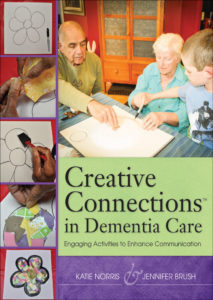
We communicate in some way with everyone around us all day. It is easy to think of communication as spoken words, but we also communicate with writing, signs, gestures, expressions, intonation, volume, colors, sounds, and even our clothing. Impaired or diminished memory, attention and concentration, perception and visuospatial functions, hearing, and visual acuity all make it difficult for people with dementia to communicate effectively.
When communicating with a person with dementia, keep these tips in mind:
Ask the person, “What would you like me to call you?”
Always speak respectfully and use age-appropriate language when communicating with older adults with dementia. Using childlike speech or words, such as “sweetie” or “honey,” is viewed negatively by most older adults. It is important to make sure that others address someone with dementia in a way the person recognizes and prefers.
Speak in a warm, easy-going manner using the tone of voice that you would like people to use when they speak with you.
Sometimes when people with dementia do not immediately understand what is being said to them, there is a tendency for the speaker to shout. This can distort speech, which can upset someone with dementia and will make communication even more difficult.
Be aware of how you are holding your body and the gestures and facial expressions you are using.
People with dementia are aware of nonverbal communication and will pay attention to it. Effectively using nonverbal forms of communication as additional cues may also help people with vision or hearing loss process information more accurately.
In conversation, don’t worry if the answers or comments are right or wrong or even if the comments make sense. Enjoy the fact that the person is engaging with you.
When you have a conversation with someone with dementia, it is your responsibility to keep that conversation going. The person may have lost that ability. Introduce topics that the person enjoys and can also understand.
Provide choice questions.
A choice question is phrased in a way that the listener must choose between two things. When you use a choice question, you are providing the information that the person can use in the answer.
“Would you like to work with clay or draw?” is much easier for a person with dementia to answer than an open-ended question, such as “What would you like to do today?”
Write choices on an index card.
Show them to the person when you ask which choice is preferred. When unable to respond verbally, the person can point to the card to answer.
Pay attention to where the person is communicating.
For example, if a person is in the kitchen or dining room, this may be an indication of hunger and preparing a snack could be a task you could do together.
Arguing, quizzing, or confronting someone with dementia will not help you communicate.
It will very likely make the person angry or more confused. Try using validating statements and adding to what the person has to say. Accept the values, beliefs, and reality of the person with dementia by agreeing with him or her, and then using the conversation to redirect the person.
If an 82-year-old man says that he needs to leave the room and go home to take care of his 10-year old son, say, “I have a son, too. He loves to build models. Would you like to help me build a model of a car?” This will help distract the person in a non-confrontational way and give him something meaningful to do.
A prompt is an easy way to gain someone’s attention.
Begin by making eye contact and saying the person’s name or placing your hand on the person’s shoulder. If you are giving an instruction, you should demonstrate first exactly what you would like the person to do.
Art is an excellent communication tool.
Art is one way that care partners can help people with dementia maintain their communication skills for as long as possible. Even if someone can no longer speak, creative expression gives people opportunities to make their needs known and to connect with others through gestures, movement, touch, and imaginative expression.
Read the book!
 Creative Connections™ in Dementia Care
Creative Connections™ in Dementia Care
Engaging Activities to Enhance Communication
By Rev. Katie Norris, and Jennifer Brush, M.A., CCC-SLP
Copyright © 2015 by Health Professions Press, Inc.
Meaningfully engage with people with dementia with the 10 easy-to-follow art projects found in this book for family and professional caregivers.
